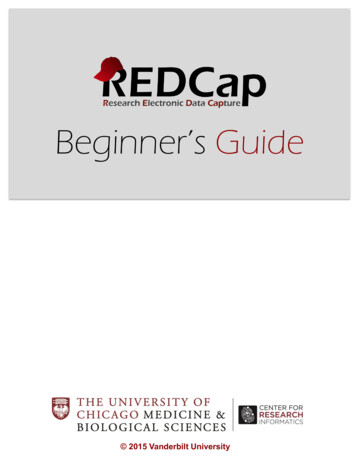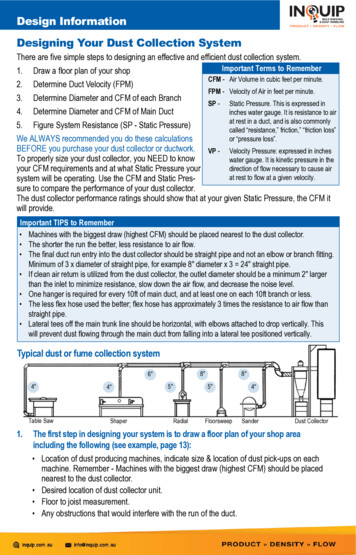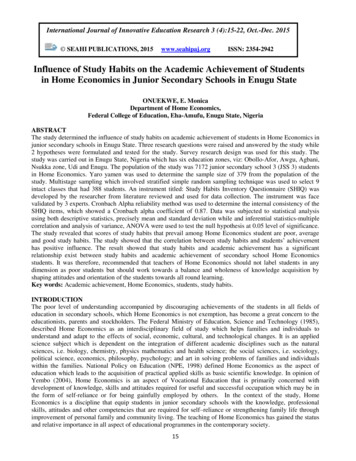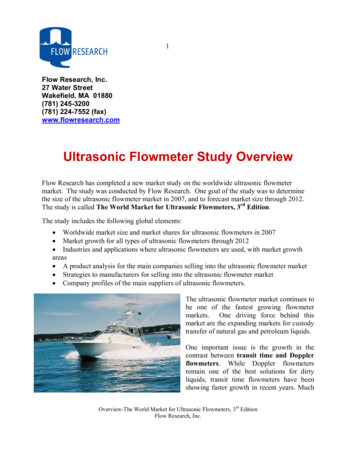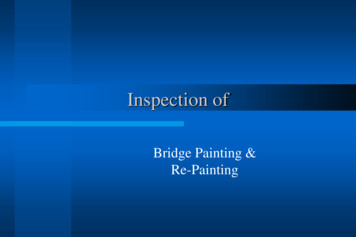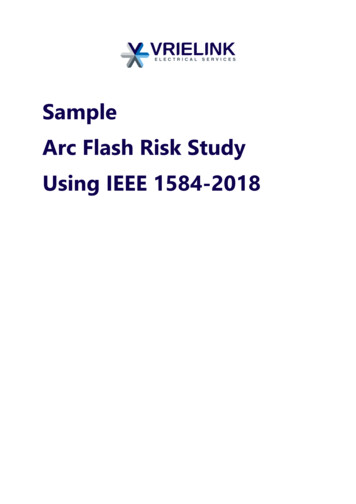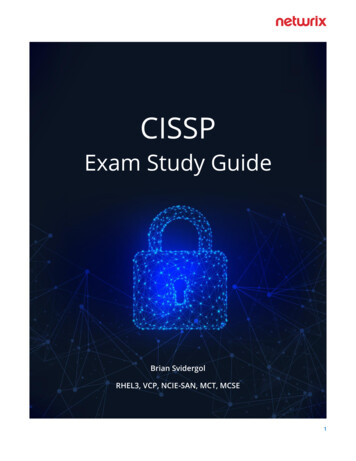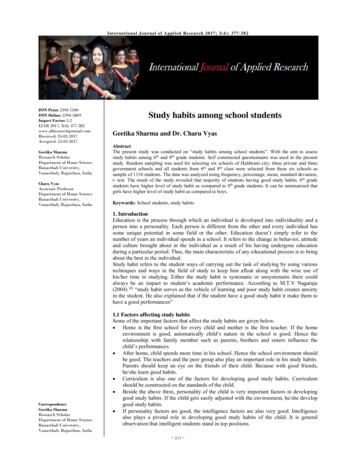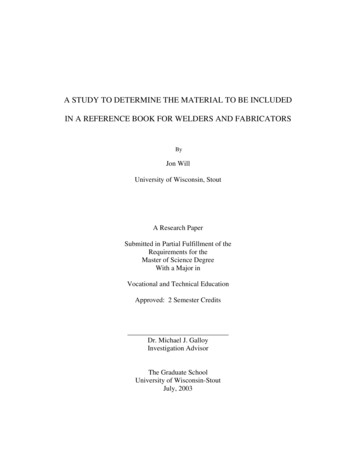
Transcription
A STUDY TO DETERMINE THE MATERIAL TO BE INCLUDEDIN A REFERENCE BOOK FOR WELDERS AND FABRICATORSByJon WillUniversity of Wisconsin, StoutA Research PaperSubmitted in Partial Fulfillment of theRequirements for theMaster of Science DegreeWith a Major inVocational and Technical EducationApproved: 2 Semester CreditsDr. Michael J. GalloyInvestigation AdvisorThe Graduate SchoolUniversity of Wisconsin-StoutJuly, 2003
The Graduate SchoolUniversity of Wisconsin StoutMenomonie, WI 54751ABSTRACTWill, Jon D.A Study to Determine the Material to be Includedin a Reference Book for Welders and FabricatorsVocational and Technical EducationDr. Michael J. GalloyAugust, 27 2003 # of Pages of your paperAmerican Psychological Association, 5th editionIn many industries, workers often require reference materials to help them perform theirjobs more effectively and efficiently. With 23 years of experience working as a welder andfabricator, the researcher has learned that welders and fabricators in industry find themselves inthe same situation. At this time there is no all-inclusive general reference book in publication forthe average welder or fabricator that deals specifically with the reference material, subjectmatter, and data needed to support the welding and fabrication trade.The purpose of this study is to verify the lack of an all-inclusive reference guide forwelders and fabricators, and to identify and rank in importance the specific content areas thatdeal with the trade and could be incorporated into a general welding reference book. A review ofii
literature showed that although there are many reference books available to welders andfabricators, no single book contains all of the information necessary for them to perform theirjobs in the most effective and efficient manner.A formal survey of a representative sample of people in welding training and inthe trade was conducted to identify what they thought should be included in an all-inclusivewelding reference book. The population surveyed were: welders and fabricators, fabricationsupervisors, and welding engineers at six welding and fabrication industries in the Eau Claire,Wisconsin metropolitan area; the students enrolled in the summer 2003 Welding Program atChippewa Valley Technical College and their instructor; and 30 welding instructors at the other15 Wisconsin Technical Colleges.The study found that 92 percent of those surveyed thought it was important to include asmain content areas: layout and fabrication hints, steel specifications, electrode identification andspecifications, conversion tables, and mathematical formulas. The study also found that79 percent believed that the 19 subtopics on the survey were important or somewhat important.The demographic data indicates that the survey population has enough years of experience,11.9 per person, to make their input on the topics relevant to the study. From the results of theresearch it is concluded that there is a need for an all-inclusive general welding reference bookfor welders and fabricators and that all of the topics in the survey are important to therespondents and should be incorporated into the book.iii
Table of ContentsPageAbstract - A Study to Determine the Material to be Includedin a Reference Book for Welders and FabricatorsiiChapter 1 – Introduction1Background of the StudyProblem StatementPurpose of the StudyObjectivesSignificance of the StudyLimitations of the StudySummary and Methodology1445566Chapter 2 - Review of Literature7TextbooksTraining ManualsGeneral Reference BooksWelding Reference BooksSteel Specification BooksElectrode and Welding Wire Classification BooksSummary8101214151617Chapter 3 - Methodology19Survey PopulationInstrumentationProceduresData Analysis19192020Chapter 4 - Data Analysis22Research ResultsDemographic DataTable 4.1 Demographic DataSurvey DataTable 4.2 Survey DataAnalysisObjective Number OneObjective Number TwoObjective Number ThreeTable 4.3 Survey Data Ranking23232424282829303131iv
Table of Contents (continued)PageSummary32Chapter 5 - Summary, Conclusions, and RecommendationsSummaryObjective Number OneObjective Number TwoObjective Number ence List39Appendix A - Survey Instrument42v
Chapter 1IntroductionBackground of the StudyIn many industries, workers often require reference materials to help them perform theirjobs more effectively and efficiently. According to Robert E. Green, editor of Machinery’sHandbook, a reference book or handbook makes a practical tool and can be used just like anyother tool, to work faster, to be less costly, and to produce a product of better quality (p. v).Those new to the workforce or to a different occupation are especially in need of the technicalcontent included in reference books dealing with their area of work. Occupations that requirereference books are numerous and wide-ranging, from the medical and legal fields to theengineering and manufacturing fields. Researchers and writers also use manuals such as thePublication Manual of the American Psychological Association, which help them use the correctformat and style in their writing. A reference book is intended to help those who are attemptingto solve a problem, perform a task, or to do a better quality job using the correct methods to getthe correct results. The welding and fabrication industry is also one of the occupations wherereference manuals are crucial.The researcher is currently a welding instructor at Chippewa Valley Technical College(CVTC). The welding department requires students in the layout and fabrication class topurchase reference material that will be useful to them in class. Students report difficulty infinding a single book containing all the material they need. A student needs several books toaccess the required information. With 23 years of experience working as a welder andfabricator, the researcher has learned that welders and fabricators in industry find themselves inthe same situation, often needing to access several different reference manuals or books in order1
to do their job properly. In addition, it is often necessary to carry reference material to variousjob sites. Not only is it cumbersome to carry more than one book, the books are often too largeto fit into the average toolbox.It would be helpful if the information required were in a single, general welding referencebook measuring no wider than 6 inches and no longer than 12 inches. This raises the followingquestions: what reference manuals or books are currently available, what information in thecurrent materials is useful, and what is missing?Student feedback indicates that current books on the market are either too specific, arewritten for education, or are too general. An example of a book that is too specific is the PipeFitter's Handbook, which pertains only to pipefitting, a small subset of welders' and fabricators'tasks. The reference data section in the book contains 86 pages of formulas and conversioncharts. The remaining 333 pages deal with pipe welding, pipe fabrication, pipe fittings, andflanges. The book is a convenient size, measuring 4 1/2 inches by 7 inches with a total of419 pages, and can be carried easily to various job sites. This is a book published for“steamfitters, pipe welders, plumbers, hydraulic fitters” Lindsey (1967), not for the generalwelder or fabricator.Textbooks designed specifically for the education of welders and fabricators deal with thetheory of welding and the basic processes used in the welding trades. Textbooks such as ModernWelding, Advanced Welding, Welding Principals and Applications, Welder’s Handbook aComplete Guide to MIG, TIG, ARC & Oxyacetylene Welding, Welding Technology, ModernWelding Technology, Welder/Fitter’s Training Guide, are used by many welding instructors.These books introduce the student to welding by covering the history of welding, the definitionof welding, and welding uses (Cary, 1998, Jeffus, 1999, Kennedy, 1982). They also offer2
specific training exercises such as those in the Welder/Fitter’s Training Guide (Stewart, 1994)and the Welder’s Handbook a Complete Guide to MIG, TIG, ARC & Oxyacetylene Welding(Finch, 1997). The reference sections containing formulas and conversion charts vary in lengthfrom 6 pages (Cary, 1998), to 13 pages in Modern Welding (Althouse, Turnquist, Bowditch,Bowditch, 1997), and 22 pages in Advanced Welding (Gibson, 1997). The size of these booksare all 8 1/2 inches by 11 1/2 inches and range in number of pages from 169 pages (Finch, 1997)to 901 pages (Jeffus, 1999) making them cumbersome to carry and use at various job sites.One pocket-sized general reference book on the market that is valuable and easy to usefor trades people (Anderson, 1993) is the Pocket Ref., by Thomas J. Glover. The size of thebook is 3 1/4 inches by 5 1/2 inches and contains 542 pages. It dedicates 8 pages to weldinginformation like electrodes, welding gases, soldering, and brazing. It has 18 pages for steel andmetal specifications, covering steel dimensions and weights of various different mild steelshapes. It also contains a 39-page math formula and functions table section. This reference bookcovers some of the topics important to welders, such as sections on welding information, steelspecifications, and references, but these sections are limited to 65 pages out of 542 pages of otherbroad content areas not dealing with welding and fabrication.To get the same information in the depth needed to be valuable and productive forwelders and fabricators, a student or trades person needs to purchase at least three books: a steelspecification book such as Ryerson Stock List from steel distributors like Joseph T. Ryerson &Son, Inc.; an electrode and welding wire specification book like Hobart Pocket Welding Guidepublished by welding distributors and manufactures such as Hobart Brothers Company; and abook that has a reference data section like the Pipe Fitter’s Handbook, which contains a math andtrigonometric section plus conversion tables. The necessity to reference several books is3
currently the only option available, making welders' and fabricators' jobs more cumbersome andultimately affecting both effectiveness and efficiency.Problem StatementThere is no all-inclusive general reference book in current publication for the averagewelder or fabricator that deals specifically with the reference material, subject matter, and dataneeded to support the welding and fabrication trade. The importance of such a reference book iswell said by John P. Stewart in The Welder’s Handbook.The welder will find the key to the skills necessary for performing work of professionalquality, where requirements dictate the need for scores of variable welding processes andapplications to suit the many varied types of alloys to be welded. Welding procedures,guidelines, recommended machine settings, charts and illustrations, and troubleshootingguides all serve not to only facilitate the operator’s struggle to meet present-day jobdemands effectively, but also to pave the way in preparing for appointments to thepositions of greater importance (1981, p. vii).Richard S. Sabo, Assistant to the CEO, The Lincoln Electric Company states TheProcedure Handbook of Arc Welding “will be of practical value to welding operators, theirsupervisors and managers, and owners of fabrication shops and steel erection firms.” (1994preface) which indicates the importance of a reference book for many related people in differentareas of a trade. The material in reference books is designed to help a worker meet job demandseffectively as well as to increase efficiency. It would be faster and easier to have the materialsthat help welders and fabricators be more effective available in one reference book instead ofseveral.Purpose of the Study4
The purpose of this study is to identify and rank in importance the specific content areasthat deal with the welding and fabrication trade that could be incorporated into a general weldingreference book.ObjectivesThe objectives for the study are:1. To identify the major content areas of a general welding reference book that would be usefulto welders and fabricators both in education and industry.2. To rank the content areas in order of importance to determine if the content area issignificantly relevant to the reference book.3. To determine subtopics which should be incorporated under each of the content areasindicated as the most important and relevant by the survey population.Significance of the Study1. A significant factor of the study is to validate the need for a general welding reference bookto support the content of the research. The pretense is that welders and fabricators now needseveral books to cover the reference data they need. Time is money and efficiency reducestime spent on a task, therefore it is logical that it would be beneficial to have a singlereference book available to welders and fabricators containing the necessary information fortheir occupation. Reducing time spent looking for information will increase both efficiencyand productivity.2. The study gathered from the survey population the material, information areas, and topicsmost often utilized by welders and fabricators. Defining the most important topics will helpto categorize the information more effectively and keep it relevant to the nature of thereference book design.5
Limitations of the Study1. The researcher developed the measuring instrument used for the study. All attempts weremade to keep the instrument valid and reliable.2. The survey population was limited to welding trades' people in the general area in and aroundEau Claire, Wisconsin, welding instructors in state of Wisconsin, and CVTC weldingstudents.3. The range of educational background and work experience in the population used in thesurvey.Summary and MethodologyThrough many years working as a welder and fabricator in the field and as a weldinginstructor, the researcher has perceived a need for one all-inclusive reference manual for bothstudents and trades people in the welding and fabricating industry.Currently, both professionals and students need to reference as many as three books inorder to perform their jobs properly. This reduces efficiency and productivity.The study attempts to identify the material useful to welders and fabricators by surveyingwelders and fabricators, fabrication supervisors, welding engineers, welding students, andwelding instructors. The researcher intends, thereby, to validate the hypothesis that there is aneed for an all-inclusive reference manual for welders and fabricators in industry and education.The following chapters will include an exhaustive literature review conducted to enhancethe researcher's already extensive knowledge on the topic. Detailed information on themethodology of the study including subjects, instrumentation, procedures, and data analysisfollow. The study concludes with a sample of the survey as well as references used in preparingthe paper.6
Chapter 2Review of LiteratureThe review of literature relating to the topic of one concise reference manual for weldersand fabricators was twofold. First, an extensive search was conducted to locate pre-existingstudies similar to this one. Second, thorough research was done to identify the welding andfabricating reference material currently available to CVTC welding students and to the generalwelding population, then to choose and analyze a representative sample of those materials.The researcher explored the Internet, Dakota County Minnesota Public Library System,University of Wisconsin Stout Library System, and CVTC Library System for studies analyzingthe problem of no single, concise reference manual for welders and fabricators. After acomprehensive search, no similar studies were found. Therefore, the review of literature willconsist of an analysis of a representative sample of the reference materials currently available towelders and fabricators.The literature is grouped into six major categories:1. Textbooks2. Training manuals3. General reference books4. Welding reference books5. Steel specification books6. Electrode and welding wire classification booksA book from each category will be analyzed according to a set of criteria so each bookwill be subjected to the same standards. The purpose of this process is to determine what is nowavailable, how it is useful, and how it is lacking.7
The criteria for analysis will be:1. Content areas2. Lack of certain content areasOnce a sample book in each of the categories has been analyzed a determination can bemade as to its practical use for both students and trades people. The review process will coverrepresentative books from each category starting with the textbook category. For purposes ofthis mini proposal only one book will be covered in each category.TextbooksFor purposes of this study textbook will be defined as "a book used in the study of asubject" (Webster, p. 913). The subject matter referred to will be welding. The textbookselected is a common book used in the teaching field and is authored by a recognized expert inthe publication industry. The book is Welding Technology second edition, G.A. Kennedy (1982)and is the book currently used at CVTC.Welding Technology second edition1. Content areasWelding Technology second edition consists of 6 parts sub-divided into 28 chapters andincludes an appendix, a glossary, and an index. It measures 8 1/2 inches by 11 1/2 inches.The book begins by covering the basics of welding, such as an introduction to thewelding processes, careers in welding, metallurgy, metal testing properties and identification,effects of heating and cooling, weld positions, and safety in welding.Other sections contain information on specific types of welding such as oxyacetylenewelding, shielded metal arc welding (SMAW), tungsten inert gas (TIG) welding, flux-corearc welding (FCAW), and metal inert gas (MIG) welding. Topics covered for each type of8
welding include the equipment needed and how to set it up, and the procedures that can beperformed. Additional information on filler rods and fluxes, electrode classification andselection, filler metals, and shielding gases is also covered.The appendix section consists of 12 pages of conversion charts and TIG weldingprocedures. There is also a pipe specification chart and a heat transformation chart. Themajority of the section is dedicated to the TIG charts, 7 pages of the 12 total pages. Theglossary and index sections are complete and useful additions to the book.2. Lack of certain content areasThere are a number of important content areas lacking in the textbook WeldingTechnology second edition. Math references, detailed electrode and filler material guides,steel specifications, dimensions, sizes, and weights are all inadequate. The book dedicatesonly 3 pages to stick electrode selection and identification. Only 10 charts in 3 chapters onTIG welding are for selecting weld polarity, tungsten, and filler metals. The book alsocontains only 12 charts for the MIG welding and FCAW processes, and welding wireselection. As well as being inadequate, the charts are scattered throughout the book makingthem difficult to locate quickly. There are only a few reference charts that show the selectionof filler metals according to base metal properties.The math section consists of six charts on metric conversion to the U.S. system andtemperature equivalents. There is no information on math formulas for area, volume,circumference, or any other needed formula used in the fabrication trade. There are notrigonometric tables or charts used in the layout processes, including the essential tables andcharts for triangles.9
The steel specification chart is limited to only one for standard pipe specifications. Thereare no charts for weights of steels and alloys or for the size and dimensions of the variousshapes of steel members. The book also lacks specifications on steel selection for specifiedapplications and intended purposes.Though Welding Technology second edition does contain much of the informationneeded for welding students, it is still inadequate on its own as a good general weldingreference book. It is also inadequate on its own for welders and fabricators in industry and isnot organized in a way that makes it easy to reference. In addition, the size is large, makingit impossible to fit into most toolboxes.All books grouped into the textbook category follow a similar format as WeldingTechnology second edition. Although textbooks are excellent for teaching weldingprinciples and practices, they are less than ideal for a general welding reference book.Training ManualsTraining manuals teach skills in a specific discipline. They begin by introducing thereader to basic concepts, and progress to complex practices. There are many styles of manualson the market, and although textbooks could be grouped into this category, they are coveredseparately because textbooks deal more with the theory of a discipline than hands-on learning.For the purpose of this research, training manuals will be referred to as those reference materialsthat deal with specific fields of study, and include written and hands-on exercises for students.The book analyzed in this section is Welder/Fitter's Training Guide, J.P. Stewart (1994) which iswidely used in the welding field.10
Welder/Fitter's Training Guide1. Content areasWelder/Fitter's Training Guide has 33 lessons covered in 168 pages and measures8 1/2 inches by 10 3/4 inches. It contains a small three-page glossary of welding terms, anindex section, and a page listing other books by the author.The training manual begins with an introduction to basic fabrication alignment tools andis followed by lessons that increase in complexity. The majority of the lessons are designedto be hands-on learning exercises. The lessons are structured very well in that they provide alist of the supplies needed to perform the lesson and the step-by-step procedures to completethem.Lessons 1, 6, 7, 8, 31, and 32 are written lessons. Even though these lessons are designedfor reading knowledge, the author provides sample hands-on exercises to help increase thereader's comprehension. Although the written exercises are not laid out with a detailedprocedure like the other chapters, they are still very useful.Welder/Fitter's Training Guide is an excellent book for teaching welding students and forbeginning fabrication people to better prepare themselves for the welding and fabricationtrade. It contains good information about the tools and methods used in the metal workingenvironment. Many of the fabrication tips and tricks of the trade are helpful to the beginner,as well as the experienced welder and fabricator.2. Lack of certain content areasAlthough Welder/Fitter's Training Guide is an excellent training guide, it lacks importantareas necessary in a general reference book for welders and fabricators. There are no mathformulas or trigonometric functions in the book. The book contains no information on steel11
specifications or material selection, electrode identification and electrode selection. Thebook contains no conversion charts, such as metric conversion, which are useful to weldersand fabricators. The book’s size also makes it less than ideal, as it is difficult to carry in atoolbox.The other books in this category closely follow the format of the Welder/Fitter's TrainingGuide, making them all inadequate for a general welding and fabrication reference book.General Reference BooksGeneral reference books contain information that can be useful to a person in any trade orarea of work. These books are more general in nature and cover a wider range of topics. Onesuch book for the welding and fabrication trade is the Pocket Ref. by Thomas J. Glover (1992),of which Anderson wrote, “The contents lean toward the applied sciences and industrial trades,although there is a general information section” (Anderson, 1993, p. 614). The book coversmany topics, which appeal to many different areas of interest; it is not designed for one specifictrade area, such as welding. It does have a small section that deals with welding but it is limitedin content.There are many such books on the market, some of which are more trade-oriented thanothers. The book reviewed in this area is Pocket Ref. second edition, Thomas J. Glover (2001).The reason for selecting this particular book is that it is commonly used in welding andfabrication education as well as in the field.Pocket Ref. second edition1. Content areasPocket Ref. second edition contains 27 topic sections and an index section with a total of542 pages, and measures 3 1/4 inches by 5 1/2 inches. The book dedicates 8 pages to12
welding information such as electrode identification, amperage suggestions for electrodesize, welding gases, soldering and brazing alloys, and fluxes. It has 18 pages for steel andmetal specifications, covering steel dimensions and weights of various mild steel shapes. Italso contains 39 pages of math formulas and function tables. The book has a 64-page sectionon various conversion factors, and a small section containing 12 pages of plumbing and pipeinformation.Pocket Ref. second edition is one of the better general reference books on the market forwelders and fabricators as it includes much of the detailed information needed in a referencebook. The math reference section is almost ideal and the conversion factors are very good.Its size is right for carrying in a toolbox and the addition of tabs makes the information easyto locate.2. Lack of certain content areasAlthough Pocket Ref. second edition contains many of the content areas needed for ageneral welding reference book, those areas are limited, lacking electrode and welding wireselection charts for given applications and materials, and specific electrode and welding wirecompositions. The steel specification section lacks material application for intended use, andthe math section lacks the ranges necessary in the decimal conversion charts.The book also lacks layout and fabrication information helpful to welders and fabricators.There are no welding procedure specifications, weld symbol identification charts, orfabrication procedures. There is no section on welding equipment and maintenance, or onwelding processes.Therefore, although Pocket Ref. second edition contains some of the detailed informationlacking in other types of books on the market, it has shortcomings and several important13
areas are not included in the book at all, making it inadequate as a general welding referenceguide.Welding Reference BooksWelding reference books deal specifically with welding and the welding trade. Thesebooks help people working in the field of welding and fabrication by providing “weldingprocedures, guidelines, recommended machine settings, charts and illustrations, and troubleshooting guides to meet present day job demands” (Stewart, 1981, p.vii). The book that willbe reviewed in this category is Pipe Fitter’s Handbook, F. R. Lindsey (1967).Pipe Fitter’s Handbook1. Content areasPipe Fitter’s Handbook consists of 5 parts and an index for a total of 419 pages, and is aconvenient carrying size, measuring 4 1/2 inches by 7 inches. The reference data section,Part 5, is very good as it contains an impressive 86 pages of math formulas, trigonometricfunctions, decimal equivalents of fractions, and conversion charts. Part 5 also contains otherreference data such as spark identification of metals, weights and measures of materials, pipesystems identification, and tank capacities. The remaining 4 parts and 333 pages deal withpipe bending, pipe fabrication, soldering and brazing, pipe fittings, and flanges. This is abook published for “steamfitters, pipe welders, plumbers, hydraulic fitters” Lindsey (1967),rather than the general welder or fabricator.2. Lack of certain content areasPipe Fitter’s Handbook does not include electrode and welding wire selection charts forgiven applications and materials, specific electrode and welding wire compositions, or steelspecifications including material application for intended use. The book lacks layout and14
fabrication information, welding procedure specifications, weld symbol identification charts,and fabrication procedures. There is no section on welding equipment and maintenance, orwelding processes.Although this book contains a good math section, overall it is too specific to the pipefitting trade and not general enough for the average welder or fabricator.Steel Specification BooksSteel specification books are published by steel distributors and steel manufactures toillustrate the material they supply. This type of book is valuable to welders, supervisors,purchasing agents, design engineers, and many other people in the metal working field. Theycontain details on weight, size, and dimensions of the various shapes of steel. Depending on thesuppler or manufacturer, the books will contain information covering everything from mild steelplate to aluminum pipe and plastics. The information in this type of book is valuable to weldersand fabricators for selecting the correct material for a given application, calculating weight of astructure for rigging and lifting, and to correctly match material sizes and types with each other.The book reviewed in this section will be Ryerson Stock List, Joseph T. Ryerson & Son, Inc.(1968).Ryerson Stock List1. Content areasRyerson Stock List contains 11 tabbed sections covering steel shapes, weights,dimensions, and plates. These sections include steel, stainless steel, aluminum, nickel, andplastic. The book also contains one small data section of conversion information includingfractions to decimal, metric to standard, and steel tolerances. It is very useful for projectdesigns, and identifying and choosing the proper materials. The book is a convenient15
carrying
Welding Technology, Welder/Fitter’s Training Guide, are used by many welding instructors. These books introduce the student to welding by covering the history of welding, the definition of welding, and welding uses (Ca
